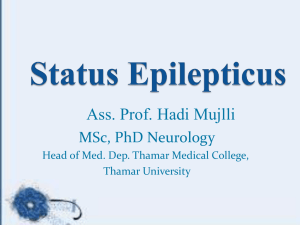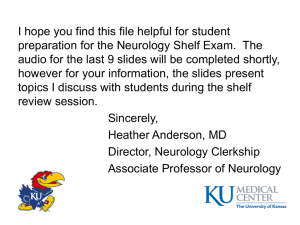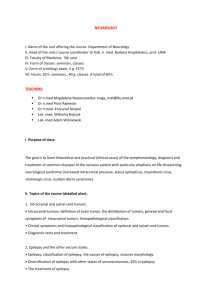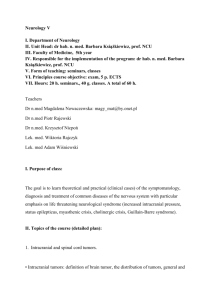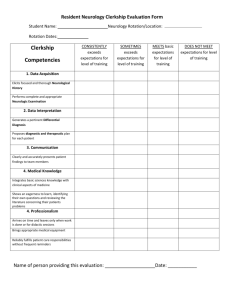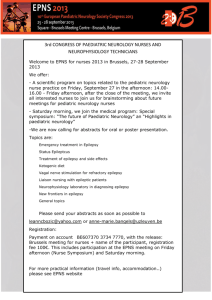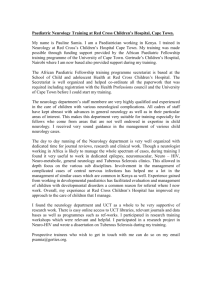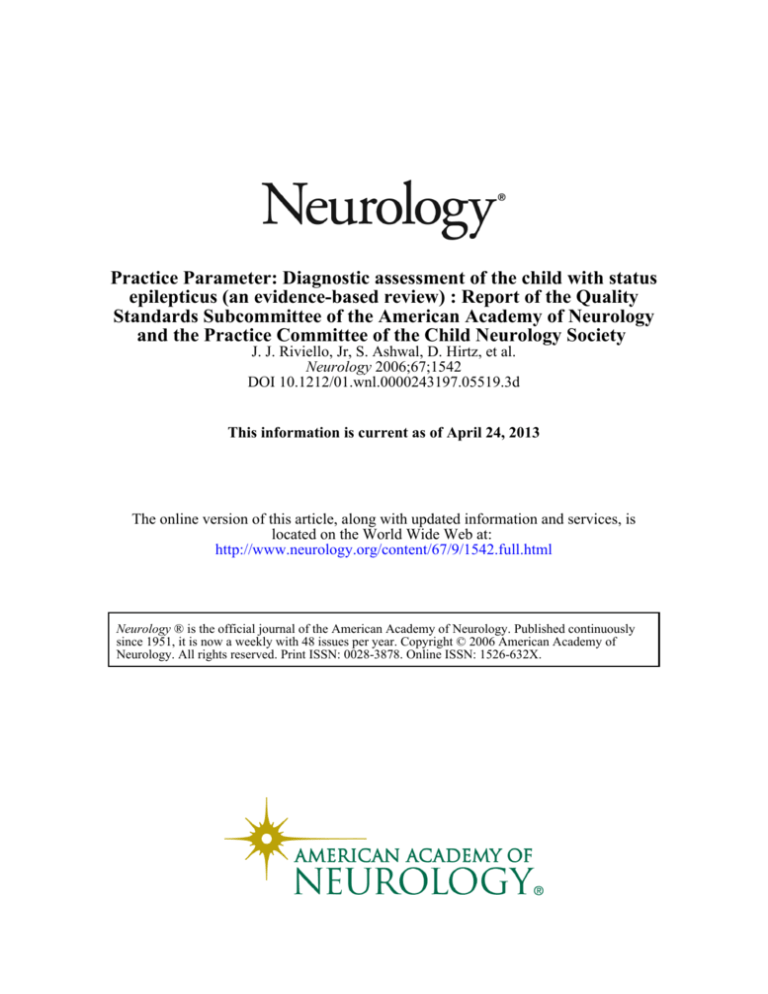
Practice Parameter: Diagnostic assessment of the child with status
epilepticus (an evidence-based review) : Report of the Quality
Standards Subcommittee of the American Academy of Neurology
and the Practice Committee of the Child Neurology Society
J. J. Riviello, Jr, S. Ashwal, D. Hirtz, et al.
Neurology 2006;67;1542
DOI 10.1212/01.wnl.0000243197.05519.3d
This information is current as of April 24, 2013
The online version of this article, along with updated information and services, is
located on the World Wide Web at:
http://www.neurology.org/content/67/9/1542.full.html
Neurology ® is the official journal of the American Academy of Neurology. Published continuously
since 1951, it is now a weekly with 48 issues per year. Copyright © 2006 American Academy of
Neurology. All rights reserved. Print ISSN: 0028-3878. Online ISSN: 1526-632X.
Special Article
Practice Parameter: Diagnostic
assessment of the child with status
epilepticus (an evidence-based review)
Report of the Quality Standards Subcommittee of the
American Academy of Neurology and the Practice
Committee of the Child Neurology Society
J.J. Riviello, Jr., MD; S. Ashwal, MD; D. Hirtz, MD; T. Glauser, MD; K. Ballaban-Gil, MD; K. Kelley, MD;
L.D. Morton, MD; S. Phillips, MD; E. Sloan, MD; and S. Shinnar, MD, PhD
Abstract—Objective: To review evidence on the assessment of the child with status epilepticus (SE). Methods: Relevant
literature were reviewed, abstracted, and classified. When data were missing, a minimum diagnostic yield was calculated.
Recommendations were based on a four-tiered scheme of evidence classification. Results: Laboratory studies (Na⫹⫹ or
other electrolytes, Ca⫹⫹, glucose) were abnormal in approximately 6% and are generally ordered as routine practice.
When blood or spinal fluid cultures were done on these children, blood cultures were abnormal in at least 2.5% and a CNS
infection was found in at least 12.8%. When antiepileptic drug (AED) levels were ordered in known epileptic children
already taking AEDs, the levels were low in 32%. A total of 3.6% of children had evidence of ingestion. When studies for
inborn errors of metabolism were done, an abnormality was found in 4.2%. Epileptiform abnormalities occurred in 43% of
EEGs of children with SE and helped determine the nature and location of precipitating electroconvulsive events (8%
generalized, 16% focal, and 19% both). Abnormalities on neuroimaging studies that may explain the etiology of SE were
found in at least 8% of children. Recommendations: Although common clinical practice is that blood cultures and lumbar
puncture are obtained if there is a clinical suspicion of a systemic or CNS infection, there are insufficient data to support
or refute recommendations as to whether blood cultures or lumbar puncture should be done on a routine basis in children
in whom there is no clinical suspicion of a systemic or CNS infection (Level U). AED levels should be considered when a child
with treated epilepsy develops SE (Level B). Toxicology studies and metabolic studies for inborn errors of metabolism may be
considered in children with SE when there are clinical indicators for concern or when the initial evaluation reveals no etiology
(Level C). An EEG may be considered in a child with SE as it may be helpful in determining whether there are focal or
generalized epileptiform abnormalities that may guide further testing for the etiology of SE, when there is a suspicion of
pseudostatus epilepticus (nonepileptic SE), or nonconvulsive SE, and may guide treatment (Level C). Neuroimaging may be
considered after the child with SE has been stabilized if there are clinical indications or if the etiology is unknown (Level C).
There is insufficient evidence to support or refute routine neuroimaging in a child presenting with SE (Level U).
NEUROLOGY 2006;67:1542–1550
Endorsed by the American College of Emergency Physicians on August 31, 2006; by the American Academy of Pediatrics on October 3, 2006; and by the
American Epilepsy Society on October 3, 2006.
From the Division of Epilepsy and Clinical Neurophysiology and the Critical Care Neurology Service (J.J.R.), Department of Neurology, Children’s Hospital,
Boston, and Harvard Medical School, MA; Division of Child Neurology (S.A.), Department of Pediatrics, Loma Linda University School of Medicine, CA, CNS
representative to the Quality Standards Committee; National Institute of Neurological Disorders and Stroke (D.H.), NIH, Bethesda, MD, CNS representative
to the Quality Standards Committee; Comprehensive Epilepsy Center (T.G.), Children’s Medical Center, Cincinnati, OH, representative of the Epilepsy
Foundation of America; Albert Einstein College of Medicine (K.B.-G.), Bronx, NY, representative of the American Epilepsy Society; Children’s Memorial
Hospital and Northwestern Medical School (K.K.), Chicago, IL, representative of the American Epilepsy Society; Division of Child Neurology (L.D.M.),
Virginia Commonwealth University, Richmond, representative of the Child Neurology Society; Children’s Hospital of Orange County (S.P.), CA, representative of the American Academy of Pediatrics; Department of Emergency Medicine (E.S.), University of Illinois at Chicago School of Medicine, representative of
the American College of Emergency Physicians; Departments of Neurology and Pediatrics (S.S.), Comprehensive Epilepsy Management Center, Montefiore
Medical Center, Albert Einstein College of Medicine, Bronx, NY.
Received March 28, 2006. Accepted in final form August 4, 2006.
Approved by the Quality Standards Subcommittee on January 28, 2006; by the Practice Committee on August 5, 2006; and by the AAN Board of Directors on
August 17, 2006.
Address correspondence and reprint requests to American Academy of Neurology, 1080 Montreal Avenue, St. Paul, MN 55116; e-mail: guidelines@aan.com
1542
Copyright © 2006 by AAN Enterprises, Inc.
Table 1 Classification of status epilepticus (SE)
Type
Definition
Examples
Acute symptomatic (26%)*
SE occurring during an acute illness (an
acute CNS insult) (an acute
encephalopathy)
Meningitis, encephalitis, electrolyte disturbance,
sepsis, hypoxia, trauma, intoxication
Remote symptomatic (33%)
SE occurring without an acute
provocation in a patient with a prior
history of a CNS insult (a chronic
encephalopathy)
CNS malformation, previous traumatic brain
injury or insult, chromosomal disorder
Remote symptomatic with an
acute precipitant (1%)
SE occurring with a chronic
encephalopathy, but with an acute
provocation
CNS malformation or previous CNS insult with
concurrent infection, hypoglycemia,
hypocalcemia, or intoxication
Progressive encephalopathy
(3%)
SE occurring with an underlying,
progressive CNS disorder
Mitochondrial disorders, CNS lipid storage
diseases, amino- or organic acidopathies
Febrile (22%)
SE occurring when the only provocation is
a febrile illness, after excluding a direct
CNS infection, such as meningitis or
encephalitis
Upper respiratory infection, sinusitis, sepsis
Cryptogenic† (15%)
SE occurring in the absence of an acute
precipitating CNS insult, systemic
metabolic disturbance, or both
No definable cause
* Data for percentages for each group are presented in more detail in appendix 4.
† The category cryptogenic is now used instead of idiopathic, which had been used in the original classification.
Status epilepticus (SE) in children, as in adults, is a
life-threatening emergency that requires prompt recognition and immediate treatment. Although various
definitions of SE have been used since 1983, the
most commonly accepted is a 30-minute duration of
seizures based on previous studies that found evidence of brain injury in adult monkeys after 45 to 60
minutes of continuous seizures.1-3 This 30-minute
definition was adopted in subsequent studies of SE
and by the working group on SE of the Epilepsy
Foundation of America.4,5 This definition also includes two or more sequential seizures without full
recovery of consciousness between seizures.5
SE is classified by seizure type and etiology.6,7 The
seizure type is determined by the origin of the epileptic discharge (i.e., focal or generalized) or if insufficient information is available, indeterminate or
unclassifiable.8-10 As defined in table 1, the etiologic
classification of SE includes 1) acute symptomatic, 2)
remote symptomatic, 3) remote symptomatic with an
acute precipitant, 4) progressive encephalopathy, 5)
febrile, and 6) cryptogenic (idiopathic).4,5,11,12 When
some of these studies were done the term idiopathic
was used for episodes now called cryptogenic. The
category idiopathic is now reserved for the genetically determined epilepsies.13 Remote symptomatic
with an acute precipitant refers to SE in a child with
a prior known diagnosis of epilepsy.
The incidence of SE in children ranges from 10 to
58 per 100,000 per year for children ages 1 to 19
Additional material related to this article can be found on the Neurology
Web site. Go to www.neurology.org and scroll down the Table of Contents for the November 14 issue to find the title link for this article.
years (mean 38.8 and median 43.8/100,000/year; 95%
CI 18.2 to 59.5/100,000/year) or would be 31,600
(range 7,300 to 41,600) children under age 18 years
in the United States per year.14-17 A higher incidence
has been reported in infants younger than 1 year of
age in two studies (135.2/100,000/year and 156/
100,000/year).14,16 SE is a common occurrence in children with epilepsy, ranging from 9.1% to 27% over
time.18-20 SE may also be the presenting manifestation of epilepsy. Symptomatic SE is common in infants and younger children. In one study of 394
children aged 1 month to 16 years, more than 80% of
children less than 2 years of age had acute symptomatic SE, febrile SE, or a progressive encephalopathy
whereas cryptogenic and remote symptomatic SE
was more common in children older than 4 years.21
SE has been reported to recur in 17% of children.22
Guidelines for AED treatment have been developed for pediatric SE,23-25 but specific pediatric guidelines have not been developed for its diagnostic
evaluation. The 1993 recommendations of the Epilepsy Foundation of America (EFA) Working Group
on Treatment of Convulsive SE included adults and
children.5 These recommendations, including a treatment sequence with antiepileptic drugs (AEDs), were
consensus, rather than evidence-based, and are currently under revision including redefining the duration considered necessary to diagnose SE.
These guidelines recommended a Dextrostix level
in all patients with SE, noting that hypoglycemia
rarely caused SE, but is obtained to avoid a glucose
infusion, and recommended consideration on an individual basis of other diagnostic studies including a
complete blood count (CBC), serum chemistries (glucose, sodium, calcium, magnesium, and BUN), AED
November (1 of 2) 2006
NEUROLOGY 67
1543
levels, and urine and blood toxicology studies. A lumbar puncture (LP) was recommended when fever occurred with SE, especially in young children, unless
a contraindication to LP was present.
This Practice Parameter reviews available evidence concerning the value of diagnostic testing in
children and adolescents with SE and provides recommendations based upon this evidence. Treatment guidelines are not included but are under
development.
Description of process. We performed a literature search through the library of the University of
Minnesota, and MEDLINE, for English-language articles from 1970 to 2005 and yielded 1,609 articles.
The search terms were as follows: status epilepticus
and, children and, MRI, cranial CT scan, lumbar
puncture, spinal tap, electrolytes, metabolic studies,
inborn errors of metabolism, EEG, hyponatremia,
hypokalemia, hypocalcemia, hypoglycemia, acidosis,
alkalosis, azotemia, hypophosphatemia, hypomagnesemia, pleocytosis, toxicology, intoxication. Seizures occurring in neonates less than 1 month of age
were excluded, as these are defined as neonatal seizures and are different in cause and prognosis. The
upper age limit was 19 years. Only articles reporting
studies with more than 20 patients were included in
this review. Articles consisting of single patient case
reports or small samples of unusual pathologic findings, that would have biased the analysis, or articles
that referred specifically to febrile or refractory SE,
were excluded. Febrile SE and refractory SE were
excluded because each is a selected population.
Twenty-five articles were identified and reviewed for
preparation of this Parameter. Relevant position papers from professional organizations were also
reviewed.
Individual committee members reviewed titles
and abstracts for content and relevance. Those papers dealing with diagnostic assessments of SE were
selected for further detailed review. Bibliographies of
the articles cited were checked for additional pertinent references. Each of the selected articles was
reviewed, abstracted, and classified by at least two
committee members. Abstracted data included the
number of patients, total episodes of SE (if given),
ages, nature of subject selection, case-finding methods (prospective, retrospective, or referral), inclusion
and exclusion criteria, classification, etiology, and
the results of laboratory, EEG, or neuroimaging
tests. A four-tiered classification scheme for determining the validity of studies on yield of established
diagnostic and screening tests developed by the
Quality Standards Subcommittee was utilized as
part of this assessment (appendix 2). Depending on
the strength of this evidence, it was decided whether
specific recommendations could be made, and if so,
the level of strength of these recommendations (appendix 3). Evidence pertinent to each diagnostic test
together with the committee’s evidence-based recommendations is presented.
1544
NEUROLOGY 67
November (1 of 2) 2006
Recommendations included in this Parameter
were based on review of data regarding the following
tests for children presenting in SE: 1) blood culture
and LP studies; 2) AED levels; 3) toxicology screening; 4) metabolic and genetic studies; 5) EEG; and 6)
neuroimaging including CT and MRI.
Most available literature did not specify whether
the diagnostic tests analyzed were uniformly applied
during each SE episode. Therefore, where reported
data were missing, we calculated a minimum diagnostic yield for each test by dividing the total number of positive diagnostic tests reported by the total
number of reported SE episodes from each study
(therefore assuming that each diagnostic test was
performed for each episode of SE, likely leading to an
underestimate of the true diagnostic yield of these
tests).
It is now common practice to obtain a CBC and
chemistry profiles routinely in children presenting
with SE. Thus, we did not develop evidence-based
recommendations for these tests but did include in
appendix 4 a summary of previous studies regarding
their diagnostic yield. Electrolyte (e.g., Na⫹⫹ or
other electrolytes, Ca⫹⫹, glucose) abnormalities or
basic metabolic disorders were reported in an average of 6% (range 1 to 16%) of children with SE. In
most studies these abnormalities were listed as the
etiology. However, it was unclear whether these abnormalities were responsible for the episode of SE
and if correction resulted in cessation of SE.
Analysis of the evidence. In 2,093 children from
20 class III studies, SE was attributed to an acute
symptomatic cause in 26%, a remote symptomatic
cause in 33%, a remote symptomatic with an acute
precipitant in 1%, a progressive encephalopathy in
3%, febrile SE in 22%, and cryptogenic in 15%
(table 1).
Laboratory studies. Should blood cultures and
LP be routinely done in children with SE? Infectious or inflammatory disorders may cause seizures
by direct involvement of the CNS, such as with meningitis or encephalitis, or by systemic involvement
affecting the brain (i.e., acute symptomatic SE). Systemic illness may aggravate pre-existing epilepsy by
lowering the seizure threshold. An infectious disorder may be included in the differential diagnosis if
fever is present or if there has been a history of fever
or preceding illness. Common clinical practice is that
blood cultures are obtained if there is a clinical suspicion of an infection and likewise LP is done when
there are clinical features suggestive of CNS infection, especially if fever is present.
Blood cultures (evidence). In six class III studies
that reported the category sepsis, with a total of 357
children, blood cultures were reported as positive in
2.5 ⫾ 0.9% (range 0.01 to 3.8%; median 2.6%; 95% CI
1.7% to 3.3%).33-35,37,38,40 This is a minimum yield
based on the assumption that blood cultures were
done in all patients with SE whether or not sepsis
was suspected. Data were not available to determine
the rate of positive blood cultures in patients in
whom sepsis was suspected. Likewise, data were not
available to ascertain the incidence of positive blood
cultures in those patients clinically considered not to
be at risk for infection.
LP (evidence). A documented CNS infection was
reported on average in 12.8 ⫾ 6.2% (range 3.4 to
26.1%; median 11.5%; 95% CI 9.9% to 15.6%) of the
1,859 children in the class III studies listed in appendix 4, but the criteria for obtaining a LP, and the
actual number done, is not known. Again, this may
represent a lower rate of positive studies than if
we knew the actual number of LPs done. In addition, if some patients who did not undergo LP had
CNS infection, this also would have raised the diagnostic yield. The variability in range may be
related to age, with a higher incidence of CNS
infections occurring in the younger children, or to
selection criteria.29,30,33,39,41
A class III study of 49 children with convulsive SE
identified 24 children with SE and fever and in this
group bacterial meningitis was detected in 4 of 9
children who had a LP done (8% of entire group and
17% of febrile group).44 None of the 25 children without febrile SE were diagnosed with meningitis. The
etiology of CNS infection in these studies was based
on author assignment of diagnosis rather than on
the reported confirmatory laboratory test results and
included bacterial meningitis in 4.8% and encephalitis in 3.0% of children. In three Class III studies (n ⫽
185),29,31,40 the following diagnoses were documented
with LP results: meningitis (14%),29,31 encephalitis
(11%),29 leukemic meningitis (1%),29 vasculitis
(0.5%),31 and shunted hydrocephalus (0.5%).29,31 In
3% of these children, pleocytosis of undetermined
etiology was found and suggested that the episode of
SE itself was the presumed cause of the pleocytosis.31
Conclusions. Data from six class III studies revealed a minimum diagnostic yield of a positive
blood culture in 2.5% of children with SE. Data
based on the 1,859 children from the studies listed in
appendix 4 revealed that the frequency of diagnosed
CNS infection rate was 12.8%. In all of these studies
there was no indication that tests were done routinely on all children with SE; it was either stated or
presumed that the tests were done selectively.
Recommendations. 1. There are insufficient data
to support or refute whether blood cultures should be
done on a routine basis in children in whom there is
no clinical suspicion of infection (Level U).
2. There are insufficient data to support or refute
whether LP should be done on a routine basis in
children in whom there is no clinical suspicion of a
CNS infection (Level U).
Should AED levels be routinely obtained in children taking AEDs who develop SE? If a child with
epilepsy treated with AEDs develops SE, it is possible that AED levels are low, because either there had
been a therapeutic response at that level or because
Table 2 Results of studies in which AED levels were obtained*
Reference
no.
AED
withdrawn
or D/C
AED
noncompliance
—
—
Class
N
Low AED
levels
45
II
51
9†
4
III
193
—
4
—
34
III
83
—
23
—
31
III
60
32
—
—
38
III
37
1
—
1
27
III
43
27
—
—
39
III
37
—
3
—
42
III
Total‡
24
5
1
—
528
74
31
1 (0.2%)
32 ⫾ 25
9 ⫾ 10
—
Median, %
21
4.2
—
Range, %
2.7–63
1–28
—
95% CI, %
8.8–51
⫺0.5–18.6
Mean, %
* Numbers in columns indicate the number of patients in each
study who had an abnormal laboratory value for that test. All
studies were class III. Fields marked with — indicates that
there was no diagnostic category in that individual study for
the column entry.
† Total number of abnormalities for each test given with percentage of total abnormalities discontinued (D/C).
‡ Four acutely withdrawn in ⬍1 week.
AED ⫽ antiepileptic drugs.
of inadequate dosing, noncompliance, or withdrawal
of the AED.
Evidence. We assumed that AED levels were obtained in those children who were supposed to be on
AEDs rather than on all children presenting in SE.
One article addressing this question was considered
class II.45 Data on AED levels were available for
review in 528 children in SE from nine studies (table
2). AED levels were low in 32% ⫾ 25% (range 2.7 to
63%; median 21%; 95% CI 8.8% to 51%) of those
children already on AEDs; they had been withdrawn
on average in 9% ⫾ 10% (range 1% to 28%; median
4.2%; 95% CI ⫺0.5% to 18.6%) and patients were
noncompliant in 0.2% overall (2.7% when specifically
mentioned as a category). Noncompliance was determined by clinical history. In one study it was reported that 4 of the 9 children with low levels had
the AED acutely withdrawn or discontinued within 1
week. However, the low AED levels reported in these
studies were not necessarily the cause of SE.7,27,45
Conclusions. Class II data showed low AED levels in 32% of children on AEDs, although this was
not necessarily the cause of the SE.
Recommendation. AED levels should be considered when a child with epilepsy on AED prophylaxis
develops SE (Level B, class II and III evidence).
Should toxicology testing be routinely ordered in
children with SE? Ingestion of a toxin or drug
abuse are possible etiologies of SE that require very
prompt diagnosis and treatment.
November (1 of 2) 2006
NEUROLOGY 67
1545
Evidence. A toxic ingestion was documented in
3.6% (range 1.5 to 5.3%; median 3.8%; 95% CI 2.3%
to 6.8%) of 1,221 children enrolled in 11 class III
studies.4,26,27,29-32,36,37,41,43 The specific toxins were theophylline, lindane, carbamazepine, or chemotherapy.
This represents a minimum rate as we used as the
denominator all patients in the studies. There is no
information on whether toxicology testing was performed based on suggestive history or physical examination findings or because initial screening
laboratory studies were negative. A routine urine
toxicology screen identifies only drugs of abuse and
specific serum toxicology levels are needed to identify specific toxins.
Conclusions. Data from 11 class III studies of
children with SE revealed a diagnosis of ingestion in
3.6%. It is not known what proportion of these ingestions was suspected. We deemed this yield high
enough to consider testing with specific serum toxicology levels, if indicated, since establishing the diagnosis is critical to treatment.
Recommendation. 1. Toxicology testing may be
considered in children with SE, when no apparent
etiology is immediately identified, as the frequency
of ingestion as a diagnosis was at least 3.6% (Level
C, class III evidence). To detect a specific ingestion,
suspected because of the clinical history, it should be
noted that a specific serum toxicology level is required, rather than simply urine toxicology
screening.
Metabolic and genetic testing. Should testing for
inborn errors of metabolism or genetic (chromosomal
or molecular) studies be routinely ordered in children with SE? Inborn errors of metabolism (IEM)
and specific chromosomal or genetic disorders may
cause neurologic dysfunction and epilepsy. In some
patients, seizures may worsen during an intercurrent illness or because of metabolic stress. Historic
features suggestive of a metabolic disorder are unexplained neonatal encephalopathy; unexplained developmental delay, especially when there is a neurologic
deterioration during an acute illness; unusual odors
to the urine; unexplained acidosis or coma, especially
with recurrent episodes of intolerance to certain
foods; the need to eat frequently to prevent lethargy;
or episodes of dehydration disproportionate to fluid
loss during an illness. The major conditions that are
considered to be IEMs include disorders of amino
acid, ammonia, and organic acid metabolism, and
disorders affecting mitochondrial and peroxisomal
functions.
Evidence. Of 735 children in nine class III studies,4,29,30,32,34,35,39,41,42 an IEM was diagnosed or present
in 4.2% of children (range 1.2 to 8.3%; median 4.0%;
95% CI 2.9% to 5.8%) based on a denominator of all
children in these studies, although it is likely that
testing was done selectively. When specified, pyridoxine dependency, Leigh’s disease, neuronal ceroid
lipofuscinosis, and a mitochondrial disorder were
each found in 0.3%, and Alper’s disease, methylmalonic acidemia, and carnitine deficency in 0.2% each.
1546
NEUROLOGY 67
November (1 of 2) 2006
Data on chromosomal or genetic disorders are not
separately available.
Conclusions. Data from nine class III studies revealed that an IEM was diagnosed in approximately
4% of children in these studies with SE.
Recommendations. 1. Studies for inborn errors of
metabolism may be considered when the initial evaluation reveals no etiology, especially if there is a
preceding history suggestive of a metabolic disorder
(Level C, class III evidence). The specific studies obtained are dependent on the history and the clinical
examination. There is insufficient evidence to support or refute whether such studies should be done
routinely (Level U).
2. There are insufficient data to support or refute
whether genetic testing (chromosomal or molecular
studies) should be done routinely in children with SE
(Level U).
Electroencephalography. Should an EEG be routinely performed in the evaluation of a child with
SE? SE is classified as generalized or focal convulsive SE or nonconvulsive SE (NCSE), and the clinical
manifestations are associated with electrographic
SE. EEG may be needed to demonstrate focality and
because the distinction of generalized vs focal epilepsy is important in the choice of chronic AED therapy. Convulsive SE occurs with overt clinical signs,
such as tonic, tonic-clonic, or clonic motor movements. Nonconvulsive status epilepticus (NCSE) occurs when either electrographic SE is associated
with altered awareness without overt clinical signs,
or altered awareness with subtle motor signs, such
as minimal eyelid blinking. An EEG done at the time
of SE (ictal EEG) can determine if the electrographic
discharge is focal or generalized, demonstrate NCSE,
or may also distinguish an epileptic event from a
nonepileptic event (pseudoseizures).47,48 EEG has
been recommended as routine in a Practice Parameter on the evaluation of the first nonfebrile seizure in
children; SE was specifically excluded from the evidence examined.46
Evidence. Six class III studies29,31,34,40,49,50 report
413 EEG findings in 358 children who presented in
SE and had an EEG. EEGs were obtained hours to
days after the acute episode and 89.3 ⫾ 13.6% (range
66% to 100%; median 92.9%; 95% CI 78.3% to 100%)
were abnormal. Findings were described as generalized epileptiform features in 8%, focal epileptiform
features in 16%, combined generalized and focal epileptiform features in 19%, generalized slowing in
41%, focal slowing in 6.3%, electrocerebral inactivity
in 1.9%, and normal in 7.7%. An epileptiform EEG
was noted in 43.1% of these 358 children (table 3).
One class III study (n ⫽ 407) that focused on the
prognosis of children with a first unprovoked seizure
also had EEG data on 46 children with SE.49,50 This
study found an abnormal EEG in 62% of children
with SE, compared to 41% of children whose seizures
were less than 30 minutes in duration.
Nonconvulsive status epilepticus: In adults,
NCSE is present in 14% of patients in whom convul-
Table 3 EEG findings in 358 children with status epilepticus
EEG findings
Normal
No. of
patients
Percentage
Range, %
32
7.7
0–34
169
41.0
26–93
Focal slowing
26
6.3
0–23
Epileptiform features,
generalized only
33
8.0
0–19
Epileptiform features,
focal only
66
16.0
0–47
Epileptiform features,
generalized and focal
79
19.1
0–42
8
1.9
0–3.9
Generalized slowing
Electrocerebral inactivity
Total*
413
* Refers to 413 EEG abnormalities reported in 358 patients from
six class III studies (references 29, 31, 34, 40, 49, and 50).
sive SE is controlled but in whom consciousness remains impaired.51 Data are not available regarding
the prevalence of NCSE after the control of convulsive SE in children or with other neurologic conditions (e.g., coma). A single study reported an 8%
incidence of NCSE in a mixed population of children
and adults with unexplained coma; data on children
were not reported separately.52
Pseudostatus epilepticus: Pseudostatus epilepticus, defined as a nonepileptic event that mimics SE,
may occur in children.53-55 In the only series of SE in
children that reported on pseudostatus epilepticus, 6
of 29 (21%) children admitted with convulsive SE
had pseudoseizures (class III).53
Conclusions. Data from six class III studies revealed generalized or focal epileptiform activity in
43.1% of the EEGs done for SE. Abnormalities on
EEG occur in 62% of children with SE compared to
41% of children with a first unprovoked seizure less
than 30 minutes duration. Sufficient data on the
prevalence of NCSE in children who presented with
SE are not available. One small class III study reported that 21% of children initially thought to be in
SE had pseudostatus.
Recommendations. 1. An EEG may be considered
in a child presenting with new onset SE as it may
determine whether there are focal or generalized abnormalities that may influence diagnostic and treatment decisions (Level C, class III evidence).
2. Although NCSE occurs in children who present
with SE, there are insufficient data to support or refute
recommendations regarding whether an EEG should
be obtained to establish this diagnosis (Level U).
3. An EEG may be considered in a child presenting with SE if the diagnosis of pseudostatus epilepticus is suspected (Level C, class III evidence).
Neuroimaging. Should CT or MRI be performed
in children with SE? Neuroimaging studies were
recommended based on specific clinical circumstances by the Practice Parameter for the evaluation
of a first afebrile seizure in children.46 Emergent
neuroimaging was recommended if there was a focal
deficit that did not quickly resolve or if there was no
return to baseline mental status after several hours,
and nonurgent MRI should be seriously considered
in any child with a seizure of partial (focal) onset
with or without secondary generalization.
A previously published Practice Parameter on
neuroimaging in the patient presenting with a seizure to the emergency department (1996) made no
recommendations concerning neuroimaging in SE,
but suggested emergent neuroimaging when a serious structural lesion was suspected, especially when
there were new onset focal deficits, persistent altered awareness, fever, recent trauma, history of
cancer, history of anticoagulation, or a suspicion of
AIDS.56 There have been no Parameters published
on the use of neuroimaging in adult or pediatric
cases of SE.
Neuroimaging should be done only after the child
is stabilized and the SE has been controlled. Neuroimaging options include CT or MRI. MRI is more
sensitive and specific than CT scanning, but CT is
readily available on an emergency basis. CT and
MRI may detect focal changes that may be transient,57 or secondary to a focal seizure (suggesting
the origin of the focus), with MRI being more sensitive. Diffusion-weighted imaging (DWI) and apparent diffusion coefficient (ADC) changes have also
been reported after SE in children and suggest cytotoxic and vasogenic edema.58-61 Progressive changes
such as hippocampal atrophy/sclerosis or global atrophy have also been documented.62 Most childhood SE
studies do not report neuroimaging findings specifically or were done before the advent of modern neuroimaging, but the diagnosis made in these studies
supports the potential usefulness of neuroimaging.
Evidence. In 20 class III studies involving 1,951
children with SE (323 before the advent of neuroimaging), structural lesions were found in 7.8% (table
E-1, on the Neurology Web site at www.neurology.
org). Specific abnormalities included CNS malformation (1.7%), trauma (1.6%), stroke/hemorrhage
(0.9%), neurocutaneous disorder (0.9%), tumor
(0.8%), infarct/vascular (0.6%), hemorrhage (0.4%),
abscess/cerebritis (0.4%), and arteriovenous malformation (AVM), hydrocephalus, or other (0.2% each).
These lesions are potentially diagnosable by
neuroimaging.
Five class III studies (n ⫽ 174) reported actual CT
data.29,31,40,49,50 Of the CT scans done in children with
SE, a mean of 49% (range 29% to 70%; median
53.4%; 95% CI 32.2% to 66.7%) were abnormal. Abnormalities included cerebral edema in 14.4%, atrophy in 12.1%, infection (meningitis/abscess/
cerebritis/granuloma) in 4.6%, CNS dysplasia in
3.5% (tuberous sclerosis and Sturge Weber syndrome, 1 each), infarction in 2.9%, tumor and hematoma in 2.3% each, 1.2% each in trauma and AVM,
and calcifications in 0.6%; an old deficit/no change
was specified in 4.6%.31 In 38 new-onset cases, CT
November (1 of 2) 2006
NEUROLOGY 67
1547
was abnormal in 29% (n ⫽ 11), with dysplasia in 4,
atrophy, infarction, and infection in 2 each, and calcifications in 1.49,50 The timing after onset of SE
when CT was done was not reported. This could affect interpretation of the presence of atrophy, which
could be secondary to the episode of SE rather than
to a preexisting abnormality. Under-representation
of a cortical dysplasia as an etiology is likely due to
the lower sensitivity of CT scanning in detecting
such malformations.
In one small class III study MRI was done in 9 of
24 children with SE.42 Imaging findings were reported as normal in two and abnormal in seven of
the nine children (78%).42 Two each had atrophy,
hydrocephalus, or cerebritis, and infarction occurred
in one.
Conclusions. We assumed that neuroimaging
was performed for clinical indications or the absence
of a known etiology. The yield of lesions important
for diagnosis and treatment was relatively high.
Data from 20 class III studies found lesions likely
detectable with neuroimaging in 7.8% of children,
based on a denominator of all available subjects in
the studies, thus these data represent an estimate of
the minimal yield of these studies. Neuroimaging
can identify structural causes for SE, especially to
exclude the need for neurosurgical intervention in
children with new onset SE without a prior history of
epilepsy, or in those with persistent SE despite appropriate treatment.
Recommendations. 1. Neuroimaging may be considered for the evaluation of the child with SE if
there are clinical indications or if the etiology is unknown (Level C, class III evidence). If neuroimaging
is done, it should only be done after the child is
appropriately stabilized and the seizure activity
controlled.
2. There is insufficient evidence to support or refute recommending routine neuroimaging (Level U).
Future research. 1. Prospective studies are
needed to define what factors, or combination of factors, may precipitate SE in children.
2. Controlled prospective studies should be conducted to define the role for routine or selective laboratory investigations in the evaluation of children
with SE. This should include studies of IEM, and
specific serum toxicology levels, as a cause of SE in
children with the diagnostic tests now available.
3. Controlled prospective blinded studies should
be conducted to define the setting and timing for
EEG done in the evaluation of children with SE, and
to determine if postictal and unexpected ictal EEG
findings have prognostic and treatment significance.
4. Controlled prospective studies with blinded assessments should examine the yield of neuroimaging, either routine or selective, in children with SE.
5. Prospective studies are needed to determine the
frequency of NCSE after the control of convulsive SE
in children, its etiology, and prognostic significance.
1548
NEUROLOGY 67
November (1 of 2) 2006
Mission statement. The Quality Standards Subcommittee (QSS) of the AAN seeks to develop scientifically sound, clinically relevant Practice Parameters for
the practice of neurology. Practice Parameters are
strategies for patient management that assist physicians in clinical decision making. A Practice Parameter is one or more specific recommendations based
on analysis of evidence of a specific clinical problem.
These might include diagnosis, symptoms, treatment, or procedure evaluation.
Disclaimer. This statement is provided as an educational service of the American Academy of Neurology. It is based on an assessment of current scientific
and clinical information. It is not intended to include
all possible proper methods of care for a particular
neurologic problem or all legitimate criteria for
choosing to use a specific procedure. Neither is it
intended to exclude any reasonable alternative
methodologies. The AAN recognizes that specific patient care decisions are the prerogative of the patient
and the physician caring for the patient, based on all
of the circumstances involved.
Conflict of interest statement. The American
Academy of Neurology is committed to producing independent, critical and truthful clinical practice
guidelines (CPGs). Significant efforts are made to
minimize the potential for conflicts of interest to influence the recommendations of this CPG. To the
extent possible, the AAN keeps separate those who
have a financial stake in the success or failure of the
products appraised in the CPGs and the developers
of the guidelines. Conflict of interest forms were obtained from all authors and reviewed by an oversight
committee prior to project initiation. AAN limits the
participation of authors with substantial conflicts of
interest. The AAN forbids commercial participation
in, or funding of, guideline projects. Drafts of the
guideline have been reviewed by at least three AAN
committees, a network of neurologists, Neurology
peer reviewers, and representatives from related
fields. The AAN Guideline Author Conflict of Interest Policy can be viewed at www.aan.com.
Appendix 1
Quality Standards Subcommittee members: Jacqueline French,
MD, FAAN (Co-Chair); Gary S. Gronseth, MD (Co-Chair); Charles
E. Argoff, MD; Stephen Ashwal, MD, FAAN (ex-officio) (facilitator); Christopher Bever, Jr., MD, MBA, FAAN; John D. England,
MD, FAAN; Gary M. Franklin, MD, MPH (ex-officio); Gary H.
Friday, MD, MPH, FAAN; Larry B. Goldstein, MD, FAAN; Deborah Hirtz, MD (ex-officio); Robert G. Holloway, MD, MPH, FAAN;
Donald J. Iverson, MD, FAAN; Leslie A. Morrison, MD; Clifford J.
Schostal, MD; David J. Thurman, MD, MPH; William J. Weiner,
MD, FAAN; Samuel Wiebe, MD.
CNS Practice Committee members: Carmela Tardo, MD (Chair);
Bruce Cohen, MD (Vice-Chair); Diane K. Donley, MD; Bhuwan P.
Garg, MD; Brian Grabert, MD; Michael Goldstein, MD; David
Griesemer, MD; Edward Kovnar, MD; Augustin Legido, MD; Leslie Anne Morrison, MD; Ben Renfroe, MD; Shlomo Shinnar, MD;
Gerald Silverboard, MD; Russell Snyder, MD; Dean Timmons,
MD; William Turk, MD; Greg Yim, MD.
Appendix 2
AAN evidence classification scheme for determining the yield of established
diagnostic and screening tests.
Class I. A statistical,1 population-based2 sample of patients studied at a
uniform point in time (usually early) during the course of the condition. All
patients undergo the intervention of interest. The outcome, if not objective,5
is determined in an evaluation that is masked to the patients’ clinical
presentations.
Class II. A statistical, non-referral-clinic-based3 sample of patients studied
at a uniform point in time (usually early) during the course of the condition.
Most (⬎80%) patients undergo the intervention of interest. The outcome, if
not objective,5 is determined in an evaluation that is masked to the patients’
clinical presentations.
Class III. A selected, referral-clinic-based4 sample of patients studied during the course of the condition. Some patients undergo the intervention of
interest. The outcome, if not objective,5 is determined in an evaluation by
someone other than the treating physician.
Class IV. Expert opinion, case reports or any study not meeting criteria for
class I to III.
This is a classification scheme developed by the QSS for studies related
to determining the yield of established diagnostic and screening tests or
interventions and is appropriate only when the diagnostic accuracy of the
test or intervention is known to be good. Additionally, the abnormality
potentially identified by the screening intervention should be treatable or,
should have important prognostic implications. This classification is different than others currently recommended by the QSS that have been published in recent parameters that relate to diagnostic, prognostic or
therapeutic studies.
(1) Statistical sample: a complete (consecutive), random or systematic
(e.g., every third patient) sample of the available population with the disease; (2) Population-based: The available population for the study consists
of all patients within a defined geographic region; (3) Non-referral-clinicbased: The available population for the study consists of all patients
presenting to a primary care setting with the condition; (4) Referral-clinicbased: The available population for the study consists of all patients referred to a tertiary care or specialty setting. These patients may have been
selected for more severe or unusual forms of the condition and thus may be
less representative; (5) Objective: An outcome measure that is very unlikely
to be affected by an observers’ expectations (e.g., determination of death,
the presence of a mass on head CT, serum B12 assays).
Appendix 3
Classification of recommendations
A ⫽ Established as effective, ineffective, or harmful for the given condition
in the specified population. (Level A rating requires at least two consistent Class I studies.)
B ⫽ Probably effective, ineffective, or harmful for the given condition in the
specified population. (Level B rating requires at least one Class I study
or at least two consistent Class II studies.)
C ⫽ Possibly effective, ineffective, or harmful for the given condition in the
specified population. (Level C rating requires at least one Class II
study or two consistent Class III studies.)
U ⫽ Data inadequate or conflicting; given current knowledge, test is unproven.
Appendix 4
Classification and laboratory data from class III studies of children presenting with status epilepticus (SE)*
Reference
No. of
patients
Acute
symptomatic
Remote
symptomatic
Remote
symptomatic
with an
acute
precipitant
Progressive
encephalopathy
Febrile
Cryptogenic
Elec/
DeH2O
Met
Sepsis
CNS
infection
26
239
63
40
—
10
67
59
18
—
29
27
218
87
72
—
3
50
6
25
—
30
28
189
26
86
—
—
77
—
8
10
29
153
71
59
—
2
21
—
5
—
40
30
139
56
9
—
10
57
7
—
14
26
31
114
17
66
7
—
16
8
5
—
8
32
112
25
69
1
7
5
5
1
—
10
4
193
45
45
—
11
46
46
—
4
33
90
24
33
6
—
27
—
2
—
1
18
34
83
13
42
—
2
—
26
1
—
2
8
35
65
13
10
—
3
24
15
—
3
1
36
59
8
29
3
—
18
1
2
—
37
52
16
17
—
2
11
6
6
—
2
38
37
14
16
—
—
6
1
—
3
1
39
37
22
5
—
4
2
4
—
4
40
30
12
14
—
—
3
1
2
2
41
25
11
8
—
1
3
2
4
—
42
24
6
9
—
—
1
8
Total‡
43§
†
1,859
234
SE
2,093
classification,
all studies
—
1
71
(3.8%)
39
(2.1%)
19
66
—
2
114
33
—
—
548
(26%)
695
(33%)
17
(1%)
57
(3%)
471
(22%)
305
(15%)
—
—
14
8
2
6
4
8
1
3
5
4
8
(0.4%)
233
(12.8%)
Specific electrolyte abnormalities were noted as follows: Na (n ⫽ 28, 1.5%); Ca⫹⫹ (n ⫽ 9, 0.5%); glucose (n ⫽ 10, 0.5%).
* Numbers in columns indicate the number of patients in each study who had an abnormal laboratory value for that test.
† Fever occurred in 35% of the overall group.
‡ Total number of abnormalities for each test given with percentage of total abnormalities.
§ Maegaki included here because it contained data on SE categories but did not have data for specific etiologies.
Elec/DeH2O ⫽ electrolyte disorder or dehydration; Met ⫽ metabolic category, not otherwise specified; Na ⫽ sodium; Ca ⫽ calcium; Glu ⫽ glucose.
November (1 of 2) 2006
NEUROLOGY 67
1549
References
1. Gastaut H. Classification of status epilepticus. Adv Neurol 1983;34:15–
35.
2. Meldrum BS. Metabolic factors during prolonged seizures and their
relation to nerve cell death. Adv Neurol 1983;34:261–275.
3. Meldrum B, Brierley JB. Prolonged epileptic seizures in primates: ischemic cell change and its relation to ictal physiological events. Arch
Neurol 1973;28:10–17.
4. Maytal J, Shinnar S, Moshe SL, Alvarez LA. Low morbidity and mortality of status epilepticus in childhood. Pediatrics 1989;83:323–331.
[Class III]
5. Dodson WE, DeLorenzo RJ, Pedley TA, Shinnar S, Treiman DM, Wannamaker BB. The treatment of convulsive status epilepticus: Recommendations of the Epilepsy Foundation of America’s Working Group on
Status Epilepticus. JAMA 1993;270:854–859.
6. Shorvon S. Status epilepticus: its clinical features and treatment in
children and adults. Cambridge: Cambridge University Press, 1994.
7. Riviello JJ, Holmes GL. The treatment of status epilepticus. Semin
Pediatr Neurol 2004;11:129–138.
8. Gastaut H. Clinical and electroencephalographic classification of epileptic seizures. Epilepsia 1970;11:102–113.
9. Commission on Classification and Terminology of the International
League Against Epilepsy. Proposal for classification of epilepsies and
epileptic syndromes. Epilepsia 1985;26:268–278.
10. Commission on Classification and Terminology of the International
League Against Epilepsy. Proposal for revised classification of epilepsies and epileptic syndromes. Epilepsia 1989;30:389–399.
11. Hauser WA, Anderson VE, Loewenson RB, McRoberts SM. Seizure
recurrence after a first unprovoked seizure. N Engl J Med 1982;307:
522–528.
12. Sahin M, Menache C, Holmes GL, Riviello JJ. Outcome of severe refractory status epilepticus in children. Epilepsia 2001;42:1461–1467.
13. Commission on Epidemiology and Prognosis, International League
Against Epilepsy. Guidelines for epidemiologic studies on epilepsy. Epilepsia 1993;34:592–596.
14. DeLorenzo RJ, Hauser WA, Towne AR, et al. A prospective, populationbased epidemiologic study of status epilepticus in Richmond, Virginia.
Neurology 1996;46:1029–1035.
15. Coeytaux A, Jallon P, Galobardes B, Morabia A. Incidence of status
epilepticus in French speaking Switzerland: (EPISTAR). Neurology
2000;55:693–697.
16. Hesdorffer DC, Logroscino G, Cascino G, Annegers JF, Hauser WA.
Incidence of status epilepticus in Rochester, Minnesota, 1965-1984.
Neurology 1998;50:735–741.
17. Wu YW, Shek DW, Garcia PA, Zhao S, Johnston SC. Incidence and
mortality of generalized convulsive status epilepticus in California.
Neurology 2002;58:1070–1076.
18. Berg AT, Shinnar S, Levy SR, Testa FM. Status epilepticus in children
with newly diagnosed epilepsy. Ann Neurol 1999;45:618–623.
19. Sillanpaa M, Shinnar S. Status epilepticus in a population-based cohort
with childhood-onset epilepsy in Finland. Ann Neurol 2002;52:303–310.
20. Berg AT, Shinnar S, Testa FM, et al. Status epilepticus after the initial
diagnosis of epilepsy in children. Neurology 2004;63:1027–1034.
21. Shinnar S, Pellock JM, Moshe SL, et al. In whom does status epilepticus
occur: age-related differences in children. Epilepsia 1997;38:907–914.
22. Shinnar S, Maytal J, Krasnoff L, Moshe SL. Recurrent status epilepticus in children. Ann Neurol 1992;31:598–604.
23. Garr RE, Appleton RE, Robson WJ, Molyneaux EM. Children presenting with convulsions (including status epilepticus) to a paediatric accident and emergency department: an audit of a treatment protocol. Dev
Med Child Neurol 1999;41:44–47.
24. Appleton R, Choonara I, Martland T, Phillips B, Scott R, Whitehouse
W. The Status Epilepticus Working Party. The treatment of convulsive
status epilepticus in children. Arch Dis Child 2000;83:415–419.
25. Appleton R, Martland T, Phillips B. Drug management for acute tonicclonic convulsions including convulsive status epilepticus in children.
Cochrane Database Syst Rev 2002:CD001905.
26. Aicardi J, Chevrie JJ. Convulsive status epilepticus in infants and
children: a study of 239 cases. Epilepsia 1970;11:187–197. [Class III]
27. Phillips SA, Shanahan RJ. Etiology and mortality of status epilepticus
in children: a recent update. Arch Neurol 1989;46:74–76. [Class III]
28. Kang du C, Lee YM, Lee J, Kim HD, Coe C. Prognostic factors of status
epilepticus in children. Yonsei Med J 2005;28:27–33. [Class III]
29. Lacroix J, Deal C, Gauthier M, Rousseau E, Farrell CA. Admissions to
a pediatric intensive care unit for status epilepticus: a 10-year experience. Crit Care Med 1994;22:827–32. [Class III]
30. Tabarki B, Yacoub M, Selmi H, Oubich F, Barasaoui S, Essoussi AS.
Infantile status epilepticus in Tunisia: clinical, etiological and prognostic aspects. Seizure 2001;10:365–369. [Class III]
31. Dunn DW. Status epilepticus in children: etiology, clinical features, and
outcome. J Child Neurol 1988;3:167–173. [Class III]
32. Scholtes FBJ, Renier WO, Meinardi H. Status epilepticus in children.
Seizure 1996;5:177–184. [Class III]
33. Chin RFM, Verhulst L, Neville BGR, Peters MJ, Scott RC. Inappropriate emergency management of status epilepticus in children contrib1550
NEUROLOGY 67
November (1 of 2) 2006
34.
35.
36.
37.
38.
39.
40.
41.
42.
43.
44.
45.
46.
47.
48.
49.
50.
51.
52.
53.
54.
55.
56.
57.
58.
59.
60.
61.
62.
63.
64.
utes to need for intensive care. J Neurol Neurosurg Psychiatry 2004;75:
1584–1588. [Class III]
Karasalihoglu S, Oner N, Celtik C, Celik Y, Biner B, Utku U. Risk
factors of status epilepticus in children. Pediatr Inter 2003;45:429–434.
[Class III]
Eriksson KJ, Koivikko MJ. Status epilepticus in children: aetiology, treatment and outcome. Dev Med Child Neurol 1997;39:652–658. [Class III]
Mah JK, Mah MW. Pediatric status epilepticus: a perspective from
Saudi Arabia. Pediatr Neurol 1999;20:364–369. [Class III]
Yager JY, Cheang M, Seshia SS. Status epilepticus in childhood. Can
J Neurol Sci 1988;15:402–404. [Class III]
Garzon E, Fernandes RMF, Sakamoto AC. Analysis of clinical characteristics and risk factors for mortality in human status epilepticus.
Seizure 2003;12:337–345. [Class III]
Kwong KL, Lee SL, Yung A, Wong VCN. Status epilepticus in 37
Chinese children: aetiology and outcome. J Paediatr Child Health 1995;
31:395–398. [Class III]
Gulati S, Kalra V, Sridhar MR. Status epilepticus in Indian children in
a tertiary care center. Indian J Pediatr 2005;72:105–108. [Class III]
Kwong KL, Chang K, Lam SY. Features predicting adverse outcomes of
status epilepticus in childhood. Hong Kong Med J 2004;10:156–159.
[Class III]
Ibrahim SH, Yezdan MA, Nizami SQ. Status epilepticus in children: a
five-year experience at Aga Khan University Hospital. J Pak Med Assoc
2003;53:597–599. [Class III]
Maegaki Y, Kurozawa Y, Hanaki K, Ohno K. Risk factors for fatality
and neurological sequelae after status epilepticus in children. Neuropediatrics 2005;36:186–192. [Class III]
Chin RF, Neville BG, Scott RC. Meningitis is a common cause of convulsive status epilepticus with fever. Arch Dis Child 2005;90:66–69.
[Class III]
Maytal J, Novak G, Ascher C, Bienkowski R. Status epilepticus in
children with epilepsy: the role of antiepileptic drug levels in prevention. Pediatrics 1996;98:1119–1121. [Class II]
Hirtz D, Ashwal S, Berg A, et al. Practice parameter: Evaluating a first
non-febrile seizure in children Neurology 2000;55:616–623.
Privitera MD, Strawsurg RH. Electroencephalographic monitoring in the
emergency department. Emerg Med Clin North Am 1994;12:1089–1101.
Thomas P. Status epileptics: Indications for emergency EEG. Neurophysiol Clin 1997;27:398–405.
Shinnar S, Kang H, Berg AT, Goldensohn ES, Hauser WA, Moshe SL.
EEG abnormalities in children with a first unprovoked seizure. Epilepsia 1994;35:471–476. [Class III]
Shinnar S, Berg AT, Moshe SL, et al. The risk of seizure recurrence
following a first unprovoked afebrile seizure in childhood: An extended
follow-up. Pediatrics 1996;98:216–225. [Class III]
DeLorenzo RJ, Waterhouse EJ, Towne AR, et al. Persistent nonconvulsive status epilepticus after the control of convulsive status epilepticus.
Epilepsia 1998;39:833–840.
Towne AR, Waterhouse EJ, Boggs JG, et al. Prevalence of nonconvulsive
status epilepticus in comatose patients. Neurology 2000;54:340–345.
Pakalnis A, Paolicchi J, Gilles E. Psychogenic status epilepticus in
children: Psychiatric and other risk factors. Neurology 2000;54:969–
970. [Class III]
Tuxhorn IEB, Fischbach HS. Pseudostatus epilepticus in childhood.
Pediatr Neurol 2002;27:407–409.
Papavasiliou A, Vassaliki N, Paraskevolakos E, Kotsalis Ch, Bazigou
H, Bardani I. Psychogenic status epilepticus in children. Epilepsy Behav 2004;5:539–546.
Greenberg MK, Barsan WG, Starkman S. Practice parameter: neuroimaging on the emergency patient presenting with seizure-summary
statement. Neurology 1996;47:26–32.
Kramer RE, Luders H, Lesser RP, et al. Transient focal abnormalities
of neuroimaging studies during focal status epilepticus. Epilepsia 1987;
28:528–532.
Lansberg MG, O’Brien MW, Norbash AM, Moseley ME, Morrell M,
Albers GW. MRI abnormalities associated with partial status epilepticus. Neurology 1999;52:1021–1027.
Kim J, Chung JI, Yoon PH, et al. Transient MR signal changes in
patients with generalized tonic clonic seizure or status epilepticus: periictal diffusion-weighted imaging. AJNR Am J Neuroradiol 2001;22:
1149–1160.
Senn P, Lovblad KO, Zutter D, et al. Changes on diffusion-weighted
MRI with focal motor status epilepticus: case report. Neuroradiology
2003;45:246–249.
Scott RC, Gadian DG, King MD, Chong WK, Cox TC, Neville BGR.
Magnetic resonance imaging findings within 5 days of status epilepticus in childhood. Brain 2002;125:1951–1959.
Perez ER, Maeder P, Villemure KM, Vischer VC, Villemure JG, Deonna
T. Acquired hippocampal damage after temporal lobe seizures in 2
infants. Ann Neurol 2000;48:384–387.
Fujiwara T, Ishida S, Miyakoshi M, et al. Status epilepticus in childhood: a retrospective study of initial convulsive status and subsequent
epilepsies. Folia Psychiatr Neurol Jpn 1979;33:337–344. [Class III]
Vigevano F, DiCapua M, Fusco L, Bertini E, Maccagnani F. Status
epilepticus in infancy and childhood. J Pediatr Neurosci 1985;1:101–
112. [Class III]
Practice Parameter: Diagnostic assessment of the child with status epilepticus (an
evidence-based review) : Report of the Quality Standards Subcommittee of the
American Academy of Neurology and the Practice Committee of the Child
Neurology Society
J. J. Riviello, Jr, S. Ashwal, D. Hirtz, et al.
Neurology 2006;67;1542
DOI 10.1212/01.wnl.0000243197.05519.3d
This information is current as of April 24, 2013
Updated Information &
Services
including high resolution figures, can be found at:
http://www.neurology.org/content/67/9/1542.full.html
Supplementary Material
Supplementary material can be found at:
http://www.neurology.org/content/suppl/2007/04/24/67.9.1542.
DC2.html
http://www.neurology.org/content/suppl/2006/11/04/67.9.1542.
DC1.html
References
This article cites 54 articles, 14 of which can be accessed free
at:
http://www.neurology.org/content/67/9/1542.full.html#ref-list-1
Citations
This article has been cited by 12 HighWire-hosted articles:
http://www.neurology.org/content/67/9/1542.full.html#related-u
rls
Permissions & Licensing
Information about reproducing this article in parts (figures,
tables) or in its entirety can be found online at:
http://www.neurology.org/misc/about.xhtml#permissions
Reprints
Information about ordering reprints can be found online:
http://www.neurology.org/misc/addir.xhtml#reprintsus

